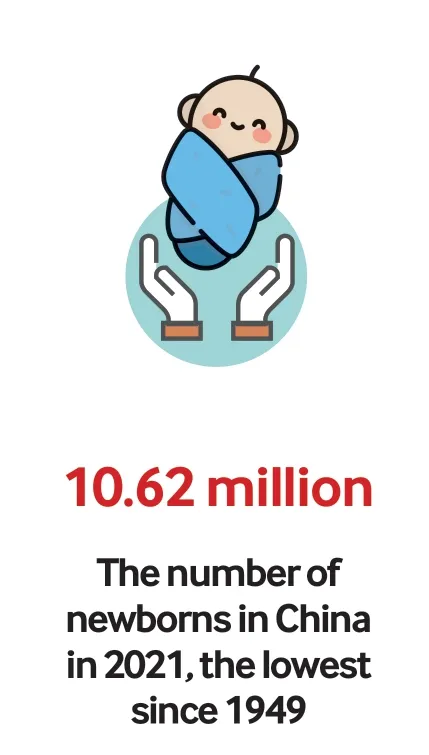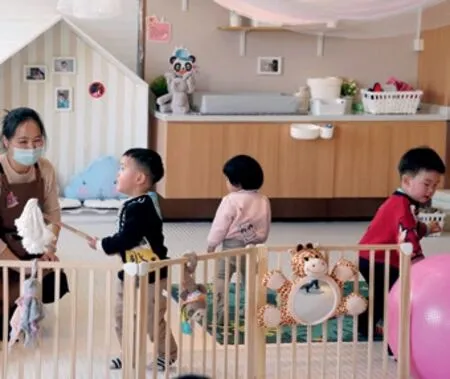Propping Up Childbirth
2022-08-30TheCentralGovernmenthasunveiledpackageofmeasurestoencouragechildbirthByJiJing
The Central Government has unveiled a package of measures to encourage childbirth By Ji Jing
Chinese authorities have issued a guideline introducing a raft of policies for prenatal and postnatal support to promote balanced long-term population development.
On August 16, 17 central departments, including the National Development and Reform Commission and the Ministry of Housing and Urban-Rural Development (NDRC), released a guideline to increase the nation’s population growth. Comprehensive measures including better maternal care services and public childcare services, improved maternity and parental leave policies,preferential policies on housing and taxation, and the fostering of fertility-friendly workplaces were included in the guideline.
According to the National Bureau of Statistics(NBS), the number of China’s newborns fell to 10.62 million in 2021, marking a decline for five consecutive years, and the birthrate fell to just 7.52 per 1,000. Both the number of newborns and birth rate were the lowest since 1949.
China introduced the family planning policy in the late 1970s to tackle overpopulation, allowing a couple to have only one child, with exceptions for ethnic minority groups and people in rural areas whose first child was a girl. In recent years, the policy has been relaxed multiple times, and all couples may have two children from 2015 onward. On July 20 last year, the Communist Party of China Central Committee and the State Council issued a decision on improving birth policies to promote long-term and balanced population development,whereby couples are encouraged to have three children.

Improving services
Hao Fuqing, Deputy Director of the Social Development Department of the NDRC, said at a press conference on August 17 that some surveys show that a lack of nursery care services is the primary factor hindering childbirth. “One third of urban families are in need of nursery services, yet supplies are unable to meet this need. Developing these services will help reduce families’ childrearing burden and increase their willingness to have children,” Hao said.
According to Hao, since 2020, the capacity of baby nurseries has increased by 200,000 slots thanks to an investment of 2 billion yuan ($292.6 million) by the Central Government and 5 billion yuan ($731.5 million) by local governments and the private sector.In spite of the development, there is much room for improvement. The number of nursery care slots per 1,000 people was 2.03 at the end of last year, a far cry from the goal of 4.5 slots per 1,000 people by the end of the 14th Five-Year Plan (2021-25) period.
The guideline said supplies of inclusive baby nursery services will be increased by developing public nursery institutions and channeling private capital into the sector.
Yang Wenzhuang, Director of the Population Monitoring and Family Development Department of the National Health Commission, said in addition to increasing supplies, prices of nursery services should be reduced. “According to our survey last year, the average charge for nursery services was 2,700 yuan ($395) per child each month and that, in large cities, it could be as high as 7,000 yuan ($1,024), making such services unaffordable for most families. Therefore, favorable policies and subsidies should be provided for nursery care institutions to reduce their costs and prices.”
According to the guideline, the prices of public nursery care institutions will be set by local governments and regulation of their fee collection will be strengthened to ensure the fees are reasonable.With financial support from the Central Government, the financial burdens these institutions bear will be reduced. For instance, discounts will be given for their water, electricity and gas usage.

A nursery in Shanghai on March 4
Favorable housing policies will be offered to families with more than one child.
The guideline said families with more than one child will enjoy favorable treatment when applying for public-rental housing (PRH). These include priority to select larger homes, shortened waiting times for PRH, and replacing their apartments with larger ones as the family size increases.
As of the end of 2021, about 69,000 families with three children had been able to access PRH, said Pan Wei with the Ministry of Housing and Urban-Rural Development.
Sharing burdens
Maternity insurance will be improved to incentivize people to have children, according to the guideline.
In China, this insurance is paid by employers. Employees covered can have their maternity medical expenses reimbursed and enjoy subsidies.
The guideline said local governments may explore ways to expand its coverage to include workers in flexible employment.
Liu Juan, an official with the National Healthcare Security Administration,said at the press conference that the number of the insured reached 240 million last year, 1.5 times that in 2012.
Liu said with the improvement of birth policies in recent years, some local governments have also set up paternity leave and child care leave in addition to the statutory maternity leave. However, the length of these leaves differs in different places, which may cause unbalanced treatment among different locations.Unifying the system will solve this problem.
The guideline said the costs of the leaves will be shared by the government,employers and employees, which will reduce employers’ burden and facilitate the implementation of the three-child policy.
According to Yang Hui, a researcher with the Women’s Studies Institute of China, a female employee who has one child creates 55,300 yuan($8,090.6) of cost for an employer and the cost of prolonged maternity leave, paternity leave and childcare leave is 32,000 yuan ($4,681.7), 5,600 yuan($819.3) and 17,700 yuan ($2,589.6), respectively.If not shared, these costs can be a heavy burden.
The guideline also stipulates the inclusion of labor analgesia and assisted reproductive technology, which will help reduce the pain of labor and assist those with fertility problems to have children,into the medical insurance. According to a survey conducted last year, nearly 60 percent of female university students said the pain of labor and its potential risks could reduce their willingness to have children.
The guideline encouraged employers to implement flexible working hours or allow employees to work from home to provide convenience for employees to pick up their children from school or look after their sick children. Employers are encouraged to include measures aimed to help employees balance work and family such as flexible working hours into the work contract. Workplaces should also set up lounges for pregnant and breast-feeding women, according to the guideline.
“The release of the guideline by the 17 departments is of great significance because it shows that the central departments are starting to tackle the childbirth problem collaboratively. The measures cover a wide range, from marriage to childbirth and from employment to housing, which is great progress,” Li Ting, Director of the Population Development Studies Center of Renmin University of China, told.
“The policies will face some problems during implementation,” Li added. For example, discrimination against women during recruitment and in workplace is a longstanding problem that is not easily solved, she said.
“It will take time for birth policy changes to have an effect. The policy’s impact hinges on people’s mindset, which is affected by one’s financial situation as well as social and cultural trends,” Li said. BR
